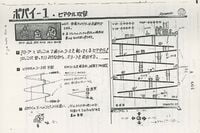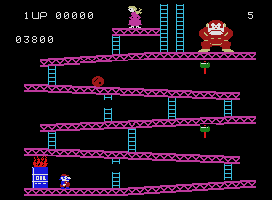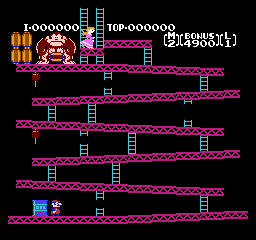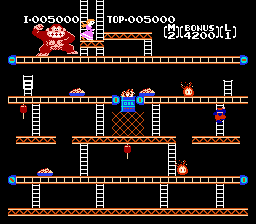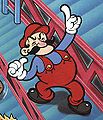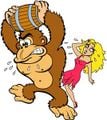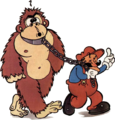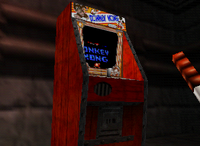Donkey Kong (game)
| It has been suggested that this page be split into Donkey Kong (game), Donkey Kong (Atari), Donkey Kong (Coleco), Donkey Kong (Ocean Software), Donkey Kong (Nintendo Entertainment System). (discuss) |
- This article is about the arcade game. For other games titled "Donkey Kong", see Donkey Kong (disambiguation).
| Donkey Kong | |||||||||||||||
|---|---|---|---|---|---|---|---|---|---|---|---|---|---|---|---|
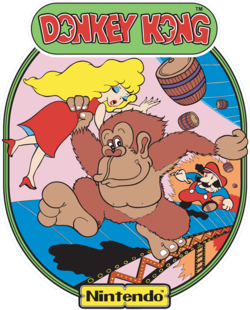 Art of the arcade cabinet For alternate box art, see the related gallery. | |||||||||||||||
| Developers | Nintendo R&D1 Nintendo R&D2 (Famicom / NES port)[1] Ikegami Tsushinki[2][3] Coleco (ColecoVision and Coleco Adam ports) Imaginative Systems Software (Atari 2600 port)[4] Roklan (Intellivision port) Atari, Inc. (Atari 8-bit port) K-Byte (TI-99/4A and NTSC Commodore 64 ports)[5][6] Softweaver (MS-DOS port)[7] Human Engineered Software (Apple II port)[8] Syndein Systems (Commodore VIC-20 port)[9] Sentient Software Ltd (ZX Spectrum and MSX ports) Arcana Software Design (Amstrad CPC and PAL Commodore 64 ports) ITDC (Atari 7800 port) HAMSTER (Arcade Archives) | ||||||||||||||
| Publishers | Nintendo Coleco (ColecoVision, Atari 2600, Intellivision, and Coleco Adam ports) Atari, Inc. (Atari 8-bit, Apple II, TI-99/4A, MS-DOS, Commodore VIC-20, and NTSC Commodore 64 ports) Ocean Software (Amstrad CPC, ZX Spectrum, MSX, and PAL Commodore 64 ports) Atari Corporation (Atari 7800 port) HAMSTER (Arcade Archives) | ||||||||||||||
| Platform | Arcade
Atari 2600, ColecoVision, Intellivision, Atari 8-bit computers, Family Computer, Nintendo Entertainment System, TI-99/4A, MS-DOS, Apple II, Commodore VIC-20, Commodore 64, Coleco Adam, MSX, ZX Spectrum, Amstrad CPC, Family Computer Disk System, Atari 7800, e-Reader, Game Boy Advance, Virtual Console (Wii, Nintendo 3DS, Wii U), Nintendo Classic Mini: Family Computer, NES Classic Edition, Nintendo Switch (Arcade Archives), Nintendo Entertainment System - Nintendo Classics
| ||||||||||||||
| Release dates | Arcade:
Atari 2600:
ColecoVision: Intellivision: Atari 8-bit computers: Family Computer: Nintendo Entertainment System: TI-99/4A: MS-DOS: Apple II: Commodore VIC-20: Commodore 64: Coleco Adam: MSX: ZX Spectrum: Amstrad CPC: Family Computer Disk System: Atari 7800: e-Reader: Game Boy Advance: Virtual Console (Wii): Virtual Console (Nintendo 3DS): Virtual Console (Wii U): Nintendo Classic Mini: Family Computer: NES Classic Edition: Nintendo Switch (Arcade Archives): Nintendo Entertainment System - Nintendo Classics: | ||||||||||||||
| Language | English | ||||||||||||||
| Genre | Platformer | ||||||||||||||
| Ratings |
| ||||||||||||||
| Mode | Up to two players (alternating turns) | ||||||||||||||
| Format | Famicom:
NES:
FDS:
Wii: Wii U: Nintendo Switch: Game Boy Advance: Nintendo 3DS: | ||||||||||||||
| Cabinet | Upright, cabaret, and cocktail | ||||||||||||||
| Monitor | Raster, standard resolution 224 x 256 (Vertical) 256 Colors | ||||||||||||||
| Input | Arcade: Joystick Atari 2600:
Famicom:
NES:
Wii: Wii U: Nintendo Switch: Game Boy Advance: Nintendo 3DS: NES Classic Edition:
| ||||||||||||||
| Serial codes | Famicom: FDS: GBA: | ||||||||||||||
- “How high can you get?”
- —Pre-level text
Donkey Kong (also referred to as The Original Donkey Kong)[33] is an arcade game that was Nintendo's first major success in North America. It marked the beginning of the Super Mario and Donkey Kong franchises and introduced several of their earliest characters, including Mario himself (a carpenter rather than a plumber), the original Donkey Kong (who, in later games, would become Cranky Kong, the current Donkey Kong's grandfather[34]), and Lady (later renamed Pauline). A port of this game was one of the three launch titles for the Family Computer in 1983. This port was released on the Nintendo Entertainment System as part of the Arcade Classics Series in 1986. The game sold very well in the United States, becoming one of four games to be inducted into the Nintendo Hall of Fame. The original arcade version had four screen levels, but the Nintendo Entertainment System version has only three, with the stage 50 m cut. This game was also the first title to be released on Virtual Console. Donkey Kong was the second platform game ever made; the 1980 game Space Panic was the first, and like Donkey Kong, it features climbing up ladders. However, Donkey Kong was the first to include jumping as an ability, and it also features a power-up to defeat enemies similar to the Power Pellets in PAC-MAN.
Story[edit]
Donkey Kong has kidnapped the beautiful Lady and taken her to a dangerous construction site somewhere in New York.[35] Mario must climb to the top of the construction site and rescue her from the Kong.
Official story quoted from Nintendo of America[edit]
“HELP! HELP!” cries the beautiful maiden as she is dragged up a labyrinth of structural beams by the ominous Donkey Kong. “SNORT. SNORT.” Foreboding music warns of the eventual doom that awaits the poor girl, lest she somehow be miraculously rescued. “But wait! Fear not, fair maiden. Little Mario, the carpenter, is in hot pursuit of you this very moment.”
Throwing fate to the wind, risking life and limb, or worse, little Mario tries desperately to climb the mighty fortress of steel, to save the lovely lady from the evil Mr. Kong. Little Mario must dodge all manner of obstacles—fireballs, plummeting beams and a barrage of exploding barrels fired at him by Donkey Kong. Amidst the beautiful girl’s constant pleas for help, your challenge is to maneuver little Mario up the steel structure, while helping him to avoid the rapid-fire succession of hazards that come his way.
As little Mario gallantly battles his way up the barriers, he is taunted and teased by Donkey Kong, who brazenly struts back and forth, beating his chest in joyful exuberance at the prospect of having the beautiful girl all to himself. It is your job to get little Mario to the top. For it is there, and only there, that he can send the mighty Donkey Kong to his mortal doom. Leaving little Mario and the beautiful girl to live happily ever after. “SIGH. SIGH.”
So, if you want the most exciting, most fun-filled, most talked about family video game on the market, don’t monkey around with anything but the original Donkey Kong.
Gameplay[edit]
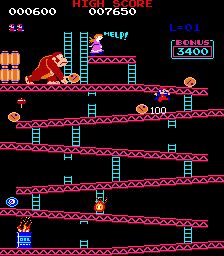
Donkey Kong stars Mario, who attempts to reach the top of a construction site where Lady is held captive. He is able to walk along platforms, jump, and climb ladders. In the process, Donkey Kong may attempt to hinder Mario from a higher location by sending obstacles towards him. Mario has the ability to jump over these obstacles or obliterate them using a Hammer; in both cases, he obtains several points that are added to a score. However, if Mario ends up falling off the side of a platform and lands on one below him (or lands on the bottom of the screen), and the height difference is greater than Mario's, he loses a life. Each time Mario reaches Lady, Donkey Kong will carry her away on a pair of ladders to the next level until the fourth stage, where he is defeated upon the level's completion.
Characters[edit]
| Character | Name | Debut | Information |
|---|---|---|---|
| Little Mario | 25 m | A carpenter, little Mario serves as the protagonist of the game, possessing the ability to jump over obstacles and wield hammers. Certain materials for the arcade version use the alternate name Jumpman.[36][37][38][39] The Arcade Archives release revives the Jumpman name in its manual.[40] | |
| Lady | 25 m | The damsel in distress, held by Donkey Kong at the end of every level. The MS-DOS and Apple II ports were the first to change her name to Pauline, followed by the Coleco Adam and then the Western NES release. Prior to these, she was named in licensed media and merchandise. | |

|
Donkey Kong | 25 m | The eponymous antagonist, Donkey Kong appears in every level at the end of each stage, hurling obstacles at Mario or guarding Lady. |
Enemies[edit]
| Enemy | Name | Debut | Information |
|---|---|---|---|
| Barrel | 25 m | Barrels are tossed by Donkey Kong throughout 25 m. Mario can easily jump over these barrels, or destroy them with a Hammer. Certain barrels appear to be blue, which will spawn a Fireball if they reach the oil drum at the beginning of the stage. | |
| Fireball | 25 m | Sentient flames that follow Mario, even climbing up ladders. They spawn from oil drums located amongst each stage and can easily be defeated with a Hammer. | |
| Fire | 100 m | Fireballs that are larger than usual, making them harder to jump over. Multiple Fires spawn from the sides of the screen and can be fended off using a Hammer. | |
| Cement tub | 50 m | Cement contained in blue tubs. They are moved along conveyor belts and kill Mario if he touches them. | |
| Jack | 75 m | Spring-like obstacles that appear in 75 m. They bound from where Donkey Kong stands before falling straight down when it reaches an edge. |
Items[edit]
| Item | Name | Effect |
|---|---|---|
| Hammer | Hammers can be used to defeat all enemies in the game. As soon as Mario grabs a hammer, he starts swinging the hammer back and forth repeatedly and strikes anything in his path. While holding the hammer, Mario cannot jump. After a certain time, the hammer disappears and cannot be used again until another one is picked up. | |
| Parasol, Hat & Bag | For each of these items Mario takes, he will gain a point bonus. |
Levels[edit]
In the Japanese arcade versions, each of the 22 playable levels consist of these four screens:
After completing the fourth screen, 100 m, the player has reached the next level, which starts at 25 m again, but with increased difficulty like more frequent barrels and faster fireballs.
In the international arcade versions, the order of the screens is more complicated with the middle screens revealed in later levels and up to six screens per level from level 5 onward.
Kill screen on Level 22[edit]
Although the game is intended to be playable indefinitely by not having a level cap, it is not normally possible to complete the first screen of level 22, due to a glitch within the calculation of the level's time limit. This is the 85th screen in the later Japanese versions (since there are 4 screens per level in these versions) and the 117th screen in the international versions.
The time limit for each level is shown as the remaining bonus, which is displayed in the top-right corner of the screen in the bonus counter; once the bonus counter hits 0, Mario dies. The initial bonus is calculated as multiplied by 100, and decreases by 100 at a time. The base value (before multiplying by 100) is stored as an 8-bit integer (which can only store values up to 255). At level 22, the bonus would be 260, but because this number is too large for one byte, it overflows modulo 256, which means the base value becomes 4, corresponding to an initial bonus of just 400. As a result, Mario dies a few seconds after starting level 22, being unable to finish it.[41]
In the first Japanese version, it is possible to get past the kill screen by exploiting another glitch which lets Mario warp to the top of the screen by jumping off the first girder and through the floor. However, the 88th screen cannot be beaten as there is not enough time to remove all the bolts. In the international versions, it is possible to get past the kill screen by exploiting a glitch which allows Mario to climb to the top of the screen by using a broken ladder. It also requires Donkey Kong to delay his fourth barrel throw for a second time after the initial delay (since the time limit is tied to his throws), which has a 1 in 32 chance of happening. It is also possible to beat the kill screen without the ladder glitch if Donkey Kong delays his fourth throw for an additional nineteen times, although this is a 1 in 3219 or 39.6 octillion chance. It is impossible to beat the 122nd screen as there is not enough time to remove all the bolts, like in the Japanese version.[42]
Development[edit]
Development of Donkey Kong began in March 1981 when Shigeru Miyamoto, under the supervision of the late Gunpei Yokoi, was assigned by Nintendo to convert Radar Scope, a poorly selling arcade game in North America, into a game that would have more appeal to more gamers. Shigeru Miyamoto later admitted that he did not focus on the story of the game, instead creating a basic plot with colorful characters and music that he himself penned.[43] He said that Mario and Lady were not intended to have a relationship, and he did not know where the idea came from, but he thought that it did not matter much.[citation needed] The game was also originally designed to have Mario escape from a maze, and jumping was not yet implemented, making platforming too difficult.[44] Originally, the four screens were supposed to be a single long stage, but this idea was scrapped due to the inability to implement vertical scrolling.[45] In a time where arcade games took around two to three months to build, Donkey Kong was built in four or five months and Shigeru Miyamoto was focused on developing it for a global market rather than just for Japan.[46] The working title during development was Table Kong Game until export manager Shinichi Todori came up with the name for both the game and the antagonist at the end of May.[47][48] Due to the late name change, the printed circuit boards (PCB) retain the "TKG" part numbering. The final version of the game was a major breakthrough for Nintendo and the video game industry, becoming one of the best selling arcade machines of its time. Its platforming gameplay also distinguished it from most other arcade games at the time.
Donkey Kong was heavily inspired by 1930s American media. It was originally conceived as a Popeye game, based on the 1930s comic and animation, with Bluto being in the role of Donkey Kong, Popeye being Mario, and Olive Oyl being Lady. The particular Popeye short that inspired Yokoi is A Dream Walking, which is set in a construction site.[49] Although Nintendo held the license to produce Popeye-branded products,[45] the characters ended up being changed for technical reasons.[48] A Popeye Game & Watch game was developed at the same time and was released only a few weeks after Donkey Kong. The Popeye arcade game came out a year later in 1982 and was followed by two more Popeye Game & Watch releases in 1983. The 1930s film King Kong would serve as another inspiration[50] and the setting of the game was New York City.[35] Coleco's American live-action commercials for Donkey Kong portrayed Mario in 1930s clothing with a fedora, and Lady was given a period appropriate hairstyle to match.
Nintendo Research & Development 1 worked on Donkey Kong, multiple Game & Watch titles, and the arcade game Sky Skipper simultaneously. Like Donkey Kong, Sky Skipper is also about rescuing captives from gorilla creatures. Miyamoto did cabinet artwork for both games.
Despite Mario originally being given the name Ossan (the Japanese term for "middle-aged man"),[51] Miyamoto envisioned Mario as a young man at around 24 or 26 years old, describing Donkey Kong as Mario's pet who escaped and kidnapped his girlfriend.[46]
Lawsuits[edit]
Universal Studios lawsuit[edit]
In 1982, around a year after the game's release, Universal Studios sued Nintendo, claiming that Donkey Kong infringed on Universal Studios's intellectual property rights to the film King Kong. Howard Lincoln, attorney and future president of Nintendo of America, decided to fight the case and hired seasoned attorney John Kirby to represent Nintendo. When Kirby showed that not only was Nintendo not likely in violation of any trademarks but also that Universal Studios themselves had sued RKO Pictures in 1975 to prove that the plot of King Kong was in fact in the public domain, Judge Robert W. Sweet ruled in Nintendo's favor, ordering Universal to pay Nintendo $1.8 million in legal fees. In an ironic twist, Judge Sweet also ruled that Tiger's King Kong video game, licensed by Universal, infringed on Donkey Kong. After the victory, Nintendo awarded John Kirby with a $30,000 sailboat, christened the Donkey Kong, and gave him "exclusive worldwide rights to use the name for sailboats."[52][53]
Crazy Kong[edit]
To meet the unexpectedly high demand for arcade machines, Nintendo licensed production to other companies.[54] Crazy Kong was an officially-licensed clone of Donkey Kong manufactured by Falcon. They were allowed to produce a certain amount of printed circuit boards (PCB) and were banned from exporting them. Falcon breached this agreement by producing more than 9000 excess units and also by exporting them to the US. On January 29, 1982, Nintendo terminated their license agreement. On June 1, Nintendo Japan filed for an injunction against Falcon in Kyoto District Court, which was granted on June 5. A countersuit by Falcon was won by Nintendo.[55] On October 13, Nintendo launched a lawsuit seeking damages against Falcon.[56] This experience led Nintendo to decide to produce all Donkey Kong Jr. machines by themselves.[57] Falcon's president was later arrested for unauthorized copying of Donkey Kong Jr. PCBs.[58]
On June 30, 1982, Nintendo of America filed a complaint toward Elcon Industries Inc., an arcade hardware manufacturer based in Michigan that sold Crazy Kong boards. The complaint alleged that the licensing agreement with Falcon explicitly forbade the manufacturing or export of Crazy Kong outside Japan. The case was taken to the United States District Court for the Eastern District of Michigan, which quickly ruled in favor of Nintendo.[59]
Ikegami Tsushinki[edit]
As Nintendo's newly established video game division lacked programming manpower, the arcade version of Donkey Kong was programmed by Ikegami Tsushinki, a contractor that had worked for Nintendo for several of its arcade releases.[2][3] For Donkey Kong's development, the two companies signed a contract which gave Ikegami Tsushinki exclusive rights to the manufacturing of Donkey Kong arcade boards.[2][3]
In 1983, Ikegami Tsushinki sued Nintendo on the ground that the company had violated the contract and produced around 80,000 arcade boards on its own.[2][3] Ikegami Tsushinki also sought compensation for the use of reverse-engineered Donkey Kong code in Donkey Kong Jr.[2][3] and claimed it owned the copyright on Donkey Kong's code (while the contract did not specify ownership of the code, a judgment relating to Space Invaders Part II set a precedent establishing computer code can be copyrighted[3]). In response, Nintendo claimed it owned Donkey Kong's code as Ikegami Tsushinki was hired as a sub-contractor.[2][3]
The case went to the Tokyo District Court until March 26, 1990, at which point the two companies settled out of court.[2][3]
Re-releases[edit]
The international arcade version of Donkey Kong was re-released by Namco as part of the compilation arcade system Donkey Kong, Donkey Kong Junior, Mario Bros. in 2004 for the North American market.
Announced at E3 2018 for the Nintendo Switch and released as part of HAMSTER Corporation's Arcade Archives brand, an emulation of the original arcade game titled Arcade Archives: Donkey Kong was released through the eShop on June 14, 2018, marking the first official release of the full arcade version of Donkey Kong for a home console since its original release 37 years earlier. The player can choose between playing the original Japanese release, the later Japanese release, and the international release of the game.
Ports[edit]
By Coleco[edit]
Coleco won the rights for the tabletop and home console ports, first as an oral agreement in November 1981, then formally on February 1, 1982.[53] All were published in 1982 except for the Coleco Adam port which was released in 1984.
- Atari 2600
- 50 m and 75 m have been cut out. Cutscenes are also absent.
- The game has much simpler graphics.
- In 25 m, only one Hammer appears instead of two. Donkey Kong does not throw the barrels, but they are automatically spawned. Fireballs and blue barrels do not appear.
- In 100 m, four large Fires spawn automatically. Mario can destroy only the second highest Fire which does not re-spawn. They do not change colors when Mario holds the hammer. They glide from one edge of their platform to the other and they cannot climb ladders.
- Shortly after its release, Coleco recalled this port due to it not working on original Atari 2600 models.[13]
- ColecoVision (Pack-in game)
- 50 m has been cut out. There are no cutscenes too.
- 25 m lacks blue barrels and Fireballs. Due to a missing girder, Donkey Kong is found on the right.
- 100 m is missing a girder, meaning that Mario only needs to remove six bolts.
- 75 m comes after 100m. There is no jack on 75 m but there are three Fires (four later on).
- Intellivision
- 50 m and 75 m have been cut out. There are no cutscenes as well.
- 25 m lacks blue barrels and Fireballs. Like the ColecoVision, Donkey Kong is on the right due to a missing girder.
- 100 m is missing a girder so there are only six bolts. There are only two Fires and they do not change color when Mario wields a hammer.
- Coleco missed their intended late August 1982 release date.[13][60] It came out in October instead.[15][61]
- The game was published by Coleco, but developed by Roklan.[62][63]
- The game does not work on the Intellivision II due to an intentional cartridge lockout, meant to affect Coleco and other third-party cartridge producers. The Intellivision II checks that valid numeric values have been put in the addresses used by the Exec routine's "Mattel Electronics Presents" startup screen. Donkey Kong skips this routine in favor of a custom Coleco startup screen, thus failing to pass the subsequent later check of the data. Donkey Kong Jr. (and other 3rd party games) would later work around this by putting appropriate values in the copyright memory locations, even though they still did not use the Exec's startup screen.
- The Intellivision staff were very angry about the release of this port, speculating that Coleco made the game intentionally look bad visually so the ColecoVision version would look superior. The more likely outcome is that Coleco simply did not have much experience programming for the Intellivision hardware.[64][dead link]
- Coleco Adam
- Unlike the ColecoVision port, Donkey Kong now throws blue barrels as well but 25 m still lacks Fireballs.
- In 75 m, there are two Fires (three later on) instead of Fireballs but the jacks have been restored and they spawn out of Donkey Kong.
- A prototype made its debut at the June 1983 Consumer Electronics Show and caused a dispute with Atari which held the rights for home computer releases. Atari canceled a nearly finished deal to distribute a localized version of the upcoming Family Computer in North America in retaliation on the mistaken belief that Nintendo gave its blessing to Coleco's port.[65] Coleco justified its existence in that the prototype used a ColecoVision cartridge as opposed to a cassette or floppy disk. Coleco agreed to not bundle this port as a pack-in game for the Adam so its release was pushed back to 1984, which by then the disastrous faults of the Adam had become well known. The released version, part of Coleco's Super Game series, uses a proprietary cassette. Nintendo awarded Atari the rights to publish Mario Bros. for both home consoles and computers outside of Japan one week after the CES.[66] These events, along with the video game crash of 1983, caused Nintendo to push back the development and release of the Nintendo Entertainment System in North America for two years.
By Atari[edit]
Atari, Inc.[edit]
Atari, Inc. won the rights for home computer ports for both Donkey Kong and its sequel in November 1982.[53][67]
- Atari 8-bit computers
- Instead of Fireballs, Fires appear in all stages. They do not change colors when Mario holds a hammer.
- 25 m is missing a girder so Donkey Kong appears on the right
- A birthday cake replaces one of Pauline's items in 50 m and 75 m
- 100 m is the only stage that has a cutscene
- Released as a cartridge
Atarisoft[edit]
Atari, Inc. created the Atarisoft brand for titles published on competing computer systems. These ports came out months after the Atari 8-bit port and were intended to be released for the Christmas shopping season but some failed to reach the market in time. All were published in 1983 or 1984.
- Texas Instruments TI-99/4A
- There are no cutscenes. Donkey Kong and Pauline are not animated
- No barrels are directly thrown at Mario in 25 m. Blue barrels set off the oil drum but does not spawn Fireballs.
- There are no jacks in 75 m
- Fires are absent, Fireballs take their place in 100 m. They do not change colors when Mario holds a hammer.
- Released as a cartridge
- MS-DOS (marketed for the IBM-PC)
- 25 m is missing a girder so Donkey Kong appears on the right
- A birthday cake replaces the purse in 75 m
- Fires take the place of Fireballs in 75 m
- Released as a floppy disk
- Apple II
- All the same gameplay issues as the MS-DOS port but graphics are slightly better
- Released as a floppy disk
- Commodore VIC-20
- There is an attract mode scene when idle at the title screen
- Mario can change direction mid-air
- A birthday cake replaces one of Pauline's items in 50 m and 75 m
- Fires are absent, Fireballs take their place in 100 m. They do not change colors when Mario holds a hammer.
- 100 m is the only stage that has a cutscene
- Released as a cartridge
- Commodore 64 (NTSC)
- This is the first official Commodore 64 port and it is for the North American market.
- Visually faithful port but Donkey Kong does not beat his chest and Pauline does not do her kicks
- Lacks the "How high can you get?" screen before stages
- Fires are absent, Fireballs take their place in 100 m. Their colors flip inside out when Mario holds a hammer.
- Released as a cartridge
Atari Corporation[edit]
Atari, Inc. was partitioned in July 1984 with the home computer and console division becoming Atari Corporation. During the June 1988 Consumer Electronics Show, Atari Corporation announced that it would release Donkey Kong, Donkey Kong Jr., and Mario Bros. for the Atari 7800.[68]
- Atari 7800
- 50 m has been cut out. The only cutscene to remain happens after 100 m is beaten.
- The graphics more closely resemble the original game than the Atari 2600 port as it was based on the Famicom / NES port.
- The same title song from the Famicom / NES port appears on the title screen.
- In 25 m, blue barrels do not appear and are instead replaced by barrels that go sideways.
- Lady's hat does not appear in 75 m.
By Ocean Software[edit]
Ocean Software previously released a bootleg version for the ZX Spectrum in 1983 called Kong. All of the following ports were published as cassettes in 1986 for the European home computer market. They use the Japanese level progression.
- Amstrad CPC
- In 75 m, Donkey Kong is not animated.
- Commodore 64 (PAL)
- MSX
- In 50 m, the umbrella is missing.
- ZX Spectrum
The Amstrad CPC and Commodore 64 ports are the most faithful to the original game, although some sounds are slightly different. In the MSX and ZX Spectrum ports, the girders of 25 m have very little sloping while Pauline is reduced to an inanimate stick figure and does not appear in 100 m until the final cutscene in which she has a larger, more detailed sprite. In the Amstrad CPC, Commodore 64, and ZX Spectrum ports, enemies do not turn blue when Mario holds a hammer and Donkey Kong is not moved by the conveyors in 50 m.
By Nintendo[edit]
Family Computer / Nintendo Entertainment System version[edit]
- Famicom / NES (as part of the Arcade Classics Series and the Donkey Kong Classics compilation game)
- The first hammer in 25 m has been moved up a tier of girders and now sits to the left of the screen.
- 50 m and all cutscenes besides the final one have been cut out.
- Lady's hat is completely absent, replaced by a second parasol in 100 m and removed entirely from 75 m. The rest of the bonus items in 100 m were also slightly rearranged.
- The color palette is darker, most notably Donkey Kong, who was orange-brown in the arcade version, is now dark brown.
- A new song was added for the title screen.
- Donkey Kong has a different animation when he lies on the ground during the 100 m cutscene, showing him wriggling his arms and legs as opposed to his eyes spinning.
- The 100 m ending song played on odd-numbered levels in the arcade game has been cut; only the song played on even-numbered levels is used.
- The kill screen is on level 133 (screen 397).[69]
- Family Computer Disk System
- Port of the NES version with various minor graphical tweaks. Most notably, when Mario scores, the points are orange instead of white.[70]
- Game Boy Advance
- The first port was for the e-Reader as part of Series Two under the name Donkey Kong-e. There is no 2 player mode.
- The second port was released as Classic NES Series: Donkey Kong.
- Virtual Console
- The first port, released in 2006, is essentially a direct port of the NES version.
- NES Classic Edition and Nintendo Classic Mini: Family Computer
- Nintendo Switch
- The NES version, with added online play, was one of the 20 NES titles made available at the Nintendo Switch Online subscription service's launch in September 2018.[71]
Donkey Kong Original Edition[edit]
- Main article: Donkey Kong Original Edition
- Virtual Console
- The second port, entitled Donkey Kong Original Edition is based on the Arcade Classics Series version but attempts to adhere to the arcade version by restoring 50 m and some animations. It was pre-installed for the European release of the Super Mario Bros. 25th Anniversary limited edition Wii bundles in 2010. In 2012, it was offered as a Club Nintendo promotional item in Japan and the United States for the Nintendo 3DS. It became available for purchase in the 3DS eShop in Europe and Australia in 2014.
As a minigame[edit]
It is featured as a minigame in the following titles:
- Donkey Kong 64 (Japanese arcade version included as a minigame)
- Animal Crossing (NES version included as minigame)
Sequels[edit]
Donkey Kong has two sequels:
In addition, the game is recreated as the start of Donkey Kong for the Game Boy.
Secrets[edit]
Atari 8-bit computers[edit]
- First, the player has to achieve a score in the 37,000s, 73,000s, or 77,000s, then lose all of their remaining lives, with the last life lost by falling off a platform. After returning to the title screen, the player should set the game difficulty to level 4, then wait for the title screen to appear again after the demo. The initials "LMD", which stands for "Landon M. Dyer", the creator of the game, will appear at the bottom of the title screen.[72]
Apple II[edit]
- Pressing 1 on the number pad gives the player extra lives.
- Pressing 2 on the number pad makes the player invincible.
Staff[edit]
- Main article: List of Donkey Kong staff
The arcade version was produced by Gunpei Yokoi, while Hiroshi Yamauchi received executive producer credit as courtesy of being Nintendo's president. Shigeru Miyamoto directed the game while an uncredited Ikegami Tsushinki did programming duties, later leading to a lawsuit over which company owned the arcade code's rights. An older version of Intelligent Systems' own website claims credit for developing the Famicom / NES port for Nintendo, but the current version changes it to Donkey Kong 3.[73] The Iwata Asks interview released for New Super Mario Bros. Wii states the port was developed by Nintendo Research & Development 2.[1] Landon M. Dyer programmed the Atari 8-bit port which served as the basis for several Atarisoft ports.
Although Ikegami Tsushinki is uncredited, a 1996 article published in Bit Magazine and written by one of the programmers involved, Hirohisa Komanome, reveals the name of the programmers who worked on the game.[74]
Nintendo eShop description[edit]
- Nintendo 3DS Nintendo eShop
Donkey Kong has kidnapped Pauline, and it is up to Mario, the fearless carpenter, to come to her rescue. Throwing fate to the wind, Mario tries desperately to climb the labyrinth of structural beams from the top of which Donkey Kong taunts him. Help our hero ascend the metal structure by dodging an assortment of fireballs, steel beams, and exploding barrels the angry ape hurls at him. Prepare yourself for a never-ending adventure as Donkey Kong takes Pauline away to the next level every time Mario gets to the top. Based on the arcade game of the same name, this classic will keep hardcore and casual gamers entertained for hours.
- Wii U Nintendo eShop
Donkey Kong has kidnapped Pauline, and it is up to Mario, the fearless carpenter, to come to her rescue. Throwing fate to the wind, Mario tries desperately to climb the labyrinth of structural beams from the top of which Donkey Kong taunts him.
Help our hero ascend the metal structure by dodging an assortment of fireballs, steel beams, and exploding barrels the angry ape hurls at him. Prepare yourself for a never-ending adventure as Donkey Kong takes Pauline away to the next level every time Mario gets to the top.
Based on the arcade game of the same name, this classic will keep hardcore and casual gamers entertained for hours.
Gallery[edit]
- For this subject's image gallery, see Gallery:Donkey Kong (game).
Donkey Kong and Lady
Multimedia[edit]
- For the complete list of media files for this subject, see Multimedia:Donkey Kong.
Arcade[edit]
| File info 0:06 |
| File info 0:03 |
| File info 0:04 |
| File info 0:04 |
| File info 0:06 |
| File info 0:02 |
Reception and legacy[edit]
Donkey Kong was introduced in simultaneous private showings at Ark Hotel in Osaka on July 9, 1981 and at the Tokyo headquarters of Nintendo Leisure System, a subsidiary that handled arcades, on the 9th and 10th.[10] Over 700 arcade operators attended these showings.[75] In the US, the game was introduced through a test run at The Spot Tavern in Renton, Washington in mid-August 1981.[11] Nintendo of America sold its first machine on September 10.[76] Donkey Kong was an immediate hit when released. Around 132,000 arcade machines were sold in Japan and North America, making it one of the most successful arcade games during the golden age of arcade video games.[77] In addition, Nintendo reaped millions of dollars from royalties through third-party ports. It was by far the most profitable game Nintendo had produced up till then and would not be surpassed until Super Mario Bros. One year from September 30, 1981, the sales of Nintendo of America went from $4.7 million to $111 million. Net revenues jumped from $64,000 to $22 million.[53]
Starting from 1982, Nintendo of America began licensing deals for Donkey Kong related merchandise and media. This led to the creation of Donkey Kong branded toys, food, a board game, a card game, collectible stickers/cards, activity books, and other goods. This culminated in the Donkey Kong and Donkey Kong Junior segments of Saturday Supercade which ran from 1983 to 1984. Most of the licensed products used the character designs from the North American flyer illustrated by Zavier Leslie Cabarga.
As a part of The Strong National Museum of Play's 2023 expansion, a playable 20-foot recreation of the arcade cabinet was built.[78]
References in later media[edit]
- Clawgrip tosses down rocks and beats his chest in a similar manner to Donkey Kong in this game.
- In the episode "Queen of the Apes", Mother Brain (in Donkey Kong's body) and her minions attack the N-Gang by throwing rolling barrels at the N-Gang, similar to how Donkey Kong does in this game.
- This game acts as a successor or remake of the arcade Donkey Kong game, with all the four levels being remade and the premise being nearly identical.
- Cranky Kong is stated to be an elder version of the original Donkey Kong.
- In the intro of this game, Cranky uses a phonograph and plays the title song from the NES version of Donkey Kong, on a structure made of girders resembling the ones from 25 m.
- The oil drums from Oil Drum Alley are the same as the ones in 25 m.
- Cranky's line, "Whisking off maidens and chucking barrels seven days a week, I was!" is a direct reference to this game.
- One of the challenge rooms in Bowser's Keep late in the game involves Mario having to dodge barrels thrown down by a Guerrilla.
- The Hammer appears as an item in this game.
- Donkey Kong's red costume and Mario's blue costume in this game are based on their respective original sprites in Donkey Kong.
- The Nintendo Power ad for the game indirectly alludes to Mario and Donkey Kong's origins as rivals by mentioning off-handedly that Mario and Donkey Kong have not "duked it out" for more than a decade.
- One of Wario's alternate costumes is based on Mario's original outfit.
- A direct port of the arcade game is playable by accessing an arcade machine in Frantic Factory.
- The song that plays in Creepy Castle is a remade version of the music that plays when Donkey Kong is climbing up the construction site with Pauline.
- A red girder that looks similar to those from 75 m can be seen inside DK's Tree House.
- The opening theme plays when confronting the Koopa Bros. in Koopa Bros. Fortress, followed by the Koopa Bros. theme.
- Mario's pixel form colors are based on his colors from the game's artwork and sprite.
- When choosing to display in 50hz or 60hz, Mario's sprite acts as the cursor; Donkey Kong's sprite can be seen to the left.
- There is a microgame based upon this game in which the player as Mario must jump over barrels.
- If Mario jumps when the Border Bros tell Luigi to jump, one of them says, "give the jumpman thing a rest", a reference to Mario's alternate name from the arcade version.
- Mario rescues Luigi at Woohoo Hooniversity by traversing a stage with rolling barrels.
- There is a skeletal pirate named Bink who tosses barrels in the Barrel minigame.
- One of the badges in this game is the Jumpman badge.
- If the player returns to the Glitz Pit and reaches first place again, one audience member says, "JUMPMAN!!! Wait, who?"
- The music that plays when Donkey Kong wins a trophy is the title theme from this game.
- During the fights with Ghastly King and Cactus King, a portion of their battle music consists of the music that plays when Donkey Kong takes Pauline up the construction site.
- One of the songs from this game is featured.
- One of the DK minigames is called "Jump, Man", and requires navigating up a series of ramps and vines over a series of falling barrels. Toadsworth even notes the similarity to the gameplay of Donkey Kong.
- Mario's baller name in this game is "The Jumpman".
- The theme of Cranky's flight school and part of Cosmic Highway feature this game's opening theme.
- 75 m appears as an unlockable stage in this game.
- The title theme appears as a cover version in this game, and the 25 m theme also appears in its original format.
- A demo of this game is available as a Masterpiece.
- Mario's down taunt, in which he spins around in midair and falls on his back, is a reference to his dying animation in this game.
- One of Wario's costumes is based on Mario's outfit from his first appearance, one of Donkey Kong's alternate costumes is based on his sprite from his first appearance and one of Peach's alternate costumes is based on Pauline's original appearance.
- Pauline and Donkey Kong appear as a sticker, using their original artwork.
- There is a microgame based upon this game in which the player must destroy a barrel rolling toward Mario by tapping it. The microgame's description also refers to Mario as Jumpman, which was changed when the microgame returned in WarioWare Gold.
- Broozers can knock around barrels, similar to Donkey Kong in this game.
- The 25 m stage can be seen in the background of Foggy Fumes.
- A statue of the Donkey Kong sprite from this game holding up a Wii Remote can be seen in Wonky Waterway.
- Some of the secret temple stages feature paintings on pillars and platforms resembling the stages from this game.
- Part of the final battle with Bowser features Bowser moving from side to side and tossing barrels at Mario in a similar manner to Donkey Kong in this game.
- Several challenges are based on the NES version of Donkey Kong.
- Donkey Kong's sprite can be seen holding a Wii U GamePad at the end of Aqueduct Assault.
- The music played and animation when the player picks up a Super Pickaxe are identical to when Mario grabs a Hammer in this game.
- The level Retro Ramp-Up is based on this game, but replacing Donkey Kong with a Spike throwing spiked balls.
- 75 m returns as a stage.
- This game is once again featured as a Masterpiece.
- Pauline appears in the form of a trophy.
- The ending of Pac-Man's debut trailer, "Red, Blue, and Yellow", subtly referenced the game by showing Mario and Donkey Kong slightly off-screen with arrows pointing to them with the year "1981" on top while Pac-Man and Mr. Game & Watch were quarreling.
- The NES version is included as a "highlight"; the player can play on 25 m, 75 m, and 100 m in three separate "scenes", each of which is 180 seconds long
- Pauline brings up the events of this game in a few lines of dialog, and stand-ins for her items appear as part of a quest to find her a gift.
- Mario's original outfit appears as the Classic Suit for Mario.
- Red girders appear in the Metro Kingdom (which is a reference to the Donkey Kong series) and are in a few parts of the city.
- Many of the billboards use art from the arcade cabinet, and Pauline and Donkey Kong's original designs appear as graffiti art on a building as well.
- The license plates for the taxi cabs read "1981-ND", a reference to the year Donkey Kong was released.
- In an 8-bit segment using sprites from Donkey Kong in the Metro Kingdom, Mario must climb girders while avoiding barrels.
- Oil drums appear, along with coins spelling out "DK".
- The music for 25 m can be heard in "Jump Up, Super Star!", as well as during the ending cutscene variation of "Break Free (Lead the Way)".
- The sound effect that plays when Mario jumps over a barrel can be heard in the aforementioned riff.
- The Phantom mentions Donkey Kong in his song.
- The Barrel Bonker references how Donkey Kong tries to hit Mario with barrels in this game.
- In an area of the Donkey Kong Adventure DLC, a stone structure resembling the 25 m stage can be seen, where a Rabbid is found jumping over barrels that another Rabbid is throwing while imitating Donkey Kong's movements and the 25 m theme plays in the background.
- Beep-0 remarks that the Rabbid would be lucky to get to 125 meters unless he finds a Hammer.
- 75 m returns as a stage yet again.
- Donkey Kong and Pauline (under her original name Lady) appear as a Legend-class spirit, using their original artwork.
- Portions of this game can be seen on Times Square's screens in all variations of the New York Minute track.
- Mario (Classic) uses Mario's original outfit colors.
- In the fitness center, there is an exercise bike that gives Luigi a key. The tune that plays when Luigi gets the key from the bike is the Hammer theme.
- When Mario walks while the Retro Soundbox is equipped, he makes the walking sound effect from Donkey Kong.
- Donkey Kong is referenced as an arcade game called Jump Man.
- A character named Giuseppe resembles Mario's look from Donkey Kong and can be seen playing it in the movie.
- The boot up song when starting a new game is briefly heard when Mario defeats Donkey Kong in the Great Ring of Kong.
- Pauline's horn use an arrangement of the stage clear jingle.
- Several challenges are based on the NES version of Donkey Kong.
- The DK Spaceport track from the Mushroom Cup contains several references to Donkey Kong.
Names in other languages[edit]
| Language | Name | Meaning | Notes |
|---|---|---|---|
| Japanese | ドンキーコング[79] Donkī Kongu |
Donkey Kong | |
| Korean | 동키콩[80] Dongki Kong |
Donkey Kong |
Notes[edit]
- Even though Mario wears his signature red and blue clothing in the game, he wears blue and white clothing on the box art for the North American NES release.
- Nintendo Power distributed an original Donkey Kong arcade cabinet as the grand prize for the Classic NES Series sweepstakes.
- In 1982, Buckner and Garcia recorded a song titled "Do the Donkey Kong", using sound effects from the game, and released it on the album Pac-Man Fever.
- A Europe-only slot machine was made in 1996 by Maygay, based on the game.
- In 2007, a documentary film, The King of Kong: A Fistful of Quarters, directed by Seth Gordon was released. The film centers around high school teacher Steve Wiebe as he tries to achieve a world record for obtaining the highest score in the game, which at the time was held by Billy Mitchell.
- This is the very first Nintendo game to feature copy protection. Every time a barrel is destroyed, the game checks if the "INTEND" portion of the "NINTENDO" text in the copyright string has been modified. If it has, the game instantly freezes.[81]
References[edit]
- ^ a b Iwata, Satoru et al.. https://iwataasks.nintendo.com/interviews/wii/nsmb/1/0. Nintendo of America (American English). Retrieved April 29, 2023.
- ^ a b c d e f g Fahs, Travis (July 6, 2011). The Secret History of Donkey Kong. Gamasutra. Page 3. Archived May 11, 2012, 00:01:42 UTC from the original via Wayback Machine. Retrieved June 1, 2024.
- ^ a b c d e f g h Akagi, Masumi. Sore wa "Pong" kara Hajimatta. Page 305-307.
- ^ Garry Kitchen's CV. Retrieved November 10, 2024.
- ^ K-Byte WXYZ-TV Detroit 1983. YouTube. Retrieved November 11, 2024.
- ^ K-Byte. Game Developer Research Institute. Retrieved November 11, 2024.
- ^ Softweaver. Game Developer Research Institute. Retrieved November 11, 2024.
- ^ Human Engineered Software. Game Developer Research Institute. Retrieved November 11, 2024.
- ^ Syndein Systems. Game Developer Research Institute. Retrieved November 11, 2024.
- ^ a b July 15, 1981. Game Machine #169. Page 10.
- ^ a b Kohler, Chris. "Year of the Monkey". 1Up.com (Archived). Page 3 of 5. Retrieved January 1, 2025.
- ^ Donkey Kong review. Solvalou.com. Retrieved December 27, 2024.
- ^ a b c Arcade Express Volume One Number Two. Page 1 and 3.
- ^ The Video Game Update Volume One #5. Page 1.
- ^ a b October 1982. The Video Game Update. Page 6.
- ^ German Intelivision back cover
- ^ The Video Game Update Vol.2 Number 4. Page 62.
- ^ ドンキーコング. Nintendo Japan (Japanese).
- ^ December 1983. The Video Game Update. Page 137 and 144.
- ^ a b March 1984. The Video Game Update. Page 190 and 192.
- ^ Spanish Commodore 64 cassette. Retrieved November2, 2024.
- ^ Spanish MSX cassette. Retrieved November 2, 2024.
- ^ Spanish ZX Spectrum cassette. Retrieved November 2, 2024.
- ^ Spanish Amstrad CPC cassette. Retrieved November 2, 2024.
- ^ Donkey Kong (FDS). The Mushroom Kingdom. Retrieved June 1, 2024.[better source needed]
- ^ Donkey Kong (e-Reader). The Mushroom Kingdom (English). Retrieved June 1, 2024.[better source needed]
- ^ ファミコンミニ/ドンキーコング. Nintendo Co., Ltd. (Japanese). Retrieved January 16, 2025.
- ^ Super Smash Bros. Brawl Chronicle
- ^ Classic NES Series: Donkey Kong British website. Nintendo UK.
- ^ Donkey Kong at Nintendo :: Games. Archived December 7, 2010, 00:06:35 UTC from the original via Wayback Machine. Retrieved November 10, 2024.
- ^ Wii. Nintendo of Korea (Korean). Archived August 27, 2014, 22:19:17 UTC from the original via Wayback Machine. Retrieved November 11, 2025.
- ^ Donkey Kong. Nintendo.com (American English). Archived August 7, 2013, 17:04:03 UTC from the original via Wayback Machine. Retrieved June 1, 2024.
- ^ Nintendo World Championships: NES Edition. Nintendo. Retrieved August 11, 2024.
- ^ 1994. Donkey Kong Country instruction booklet. Nintendo of America (American English). Page 6 and 27.
- ^ a b April 25, 2023. インタビュー マリオ映画公開記念!宮本茂さんインタビュー 制作の始まりから驚きの設定まで. Nintendo Dream Web (Japanese). Retrieved April 25, 2023.
- ^ Donkey Kong Operation Manual. Page 2 and 5.
- ^ Control panel instructions for upright cabinets
- ^ Instructions for cocktail cabinets
- ^ Donkey Kong instruction sticker
- ^ SeafoamGaming (June 14, 2018). Arcade Archives Donkey Kong (Switch eShop)- Gameplay Footage. YouTube. Retrieved June 1, 2024.
- ^ October 28-November 14, 2007. HOW HIGH CAN YOU GET? THE FIX FOR DONKEY KONG'S KILL SCREEN. Don Hodges (English). Retrieved June 1, 2024.
- ^ Kosmic (February 1, 2025). After 44 Years, Someone Beat the Donkey Kong Kill Screen. YouTube (English). Retrieved February 1, 2025.
- ^ Cabbusses's Retro Obscurities (June 3, 2013). sm3349730 + sm3357080 + sm3358731 - マリオにゼルダ・コンピューターゲームの歴史. YouTube (Japanese). Archived February 13, 2020, 08:48:36 UTC from the original via Wayback Machine. Retrieved June 1, 2024.
- ^ Turi, Tim (November 25, 2009). Miyamoto: Mario Initially Couldn’t Jump. GameInformer. Retrieved June 1, 2024.
- ^ a b Iwata, Satoru et al.. Iwata Asks:New Super Mario Bros: Volume 1. Nintendo of America (American English). Retrieved April 29, 2023.
- ^ a b Donkey Kong Developer Interview. Nintendo.com (American English). Archived April 25, 2022, 23:46:30 UTC from the original via Wayback Machine. Retrieved June 1, 2024.
- ^ Gaming Historian (September 29, 2021). How the Mario Characters Got Their Names (12:29). YouTube. Retrieved June 1, 2024.
- ^ a b Caruso, Norman (January 22, 2020). In a deposition of Gunpei Yokoi, Yokoi states the reason Nintendo's Popeye game was abandoned was due to technical limitations. Because of this, Miyamoto came up with Mario, Pauline, and Donkey Kong.. X. Retrieved June 1, 2024.
- ^ Donkey Kong & Nintendo - Let There Be Mario.
- ^ Jackson, David S. (May 20, 1996). THE SPIELBERG OF VIDEO GAMES. Time (English). Retrieved June 1, 2024.
- ^ Iwata Asks: The Grand Culmination of Famicom Cartridges. Nintendo.com (American English). Archived October 9, 2010, 20:15:46 UTC from the original via Wayback Machine. Retrieved June 1, 2024.
- ^ Sheff, David (April 15, 1999). Game Over: Press Start to Continue: The Maturing of Mario. Wilton, Connecticut: Gamepress (English). ISBN 0-9669617-0-6. Page 126.
- ^ a b c d Universal City Studios, Inc. v. Nintendo Co. Ltd.. Justia. Retrieved March 19, 2021.
- ^ October 1, 1981. Game Machine #174. Page 24.
- ^ August 15, 1982. Game Machine #194. Page 26.
- ^ December 1, 1982. Game Machine #202. Page 26.
- ^ September 15, 1982. Game Machine #196. Page 30.
- ^ March 1, 1983. Game Machine #207. Page 30.
- ^ Nintendo of America, Inc. v. Elcon Industries, Inc. (October 4, 1982). Nintendo of America, Inc. v. Elcon Industries, Inc., 564 F. Supp. 937 - Dist. Court, ED Michigan 1982. Google Scholar. Retrieved June 1, 2024.
- ^ August 1982. The Video Game Update. Page 1.
- ^ November 1982. The Video Game Update. Page 5.
- ^ Roklan. Game Developer Research Institute. Retrieved November 2, 2024.
- ^ The History of Roklan Corporation | VCFMW 17 (2022).YouTube. Retrieved November 2,2024.
- ^ http://www.beeslife.com/intvlibrary/Games/Trivia/games_coleco.htm#Anchor-Donkey-57224
- ^ McFerran, Damien (October 6, 2022). Remember When Atari Turned Down Nintendo And Sega?. Time Extension (English). Retrieved June 1, 2024.
- ^ August 15, 1983. Game Machine #218. Page 28.
- ^ Atari History Timelines. Retrieved March 19, 2021.
- ^ History of Tramel Technology/Atari. Retrieved March 20, 2021.
- ^ Donkey Kong - Kill Screen [Nes][CompleteTheGame]. Retrieved August 18, 2024.
- ^ カセットとディスクカード両方で発売. pony.velvet.jp. Retrieved June 1, 2024.
- ^ Nintendo Entertainment System – Nintendo Switch Online. Nintendo of America (American English). Retrieved June 1, 2024.
- ^ GameTrailers (October 28, 2013). Pop Facts - Donkey Kong: LMD Initials. YouTube (English). Retrieved January 1, 2023.
- ^ ゲーム | INTELLIGENT SYSTEMS CO., LTD.. Intelligent Systems website (Japanese). Retrieved November 1, 2021.
- ^ Komanome, Hirohisa (December 26, 2002). ドンキーコング・池上通信機器事件. Archived July 14, 2008, 04:23:36 UTC from the original via Wayback Machine. Retrieved June 1, 2024.
- ^ August 1, 1981. Game Machine #170. Page 4.
- ^ September-October 1988. Nintendo Power Issue 2. Nintendo of America (American English). Page 1.
- ^ Cuthbertson, Anthony (May 5, 2017). Donkey Kong Inducted into World Video Game Hall of Fame. Newsweek. Retrieved July 9, 2021.
- ^ Parfitt, Dave (July 2, 2023). Achievement unlocked as The Strong National Museum of Play levels up with buff gamer expansion. Attractions Magazine. Retrieved July 14, 2023. (Archived July 14, 2023, 14:37:51 UTC via Wayback Machine.)
- ^ Japanese logo
- ^ Nintendo Music
- ^ The Cutting Room Floor
External links[edit]
- Official Japanese site
- Official Nintendo UK Game Boy Advance site
- Japanese Famicom manual
- North American NES manual
- Games
- Arcade games
- Virtual Console games
- Wii Virtual Console games
- Nintendo 3DS Virtual Console games
- Wii U Virtual Console games
- Nintendo Switch Online games
- Arcade Archives games
- MS-DOS games
- Donkey Kong (game)
- 1981 games
- 1982 games
- 1983 games
- 1984 games
- 1986 games
- 1987 games
- 1988 games
- Amiibo tap: Nintendo's Greatest Bits
- Classic NES Series
- Donkey Kong 64 minigames
- Platforming games
- Family Computer games
- Family Computer Disk System games
- Nintendo Entertainment System games
- Launch titles

